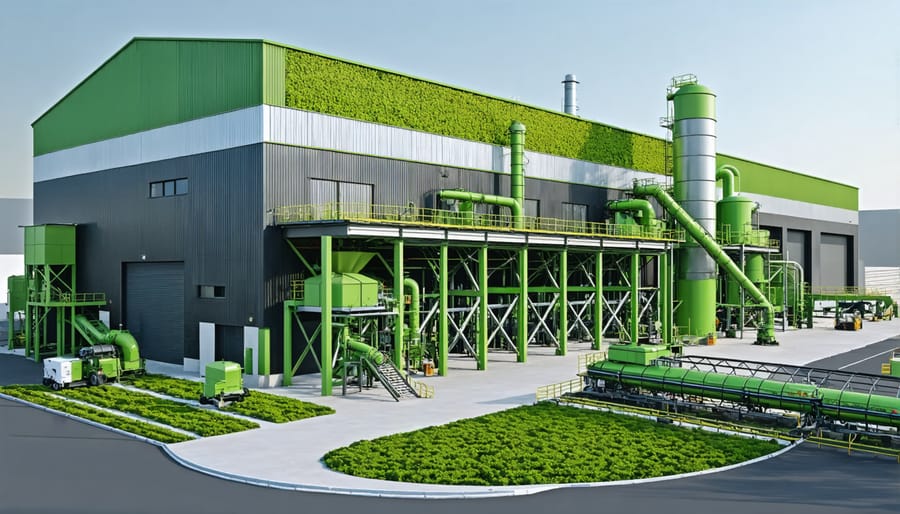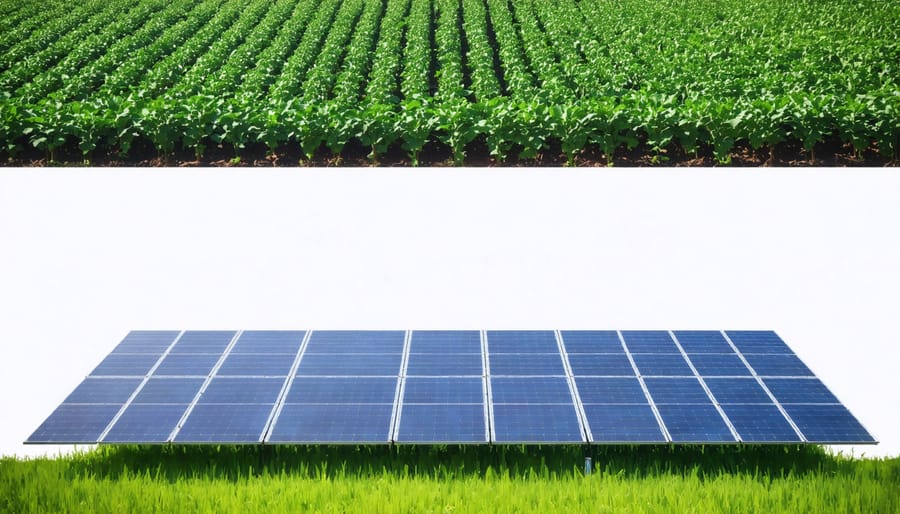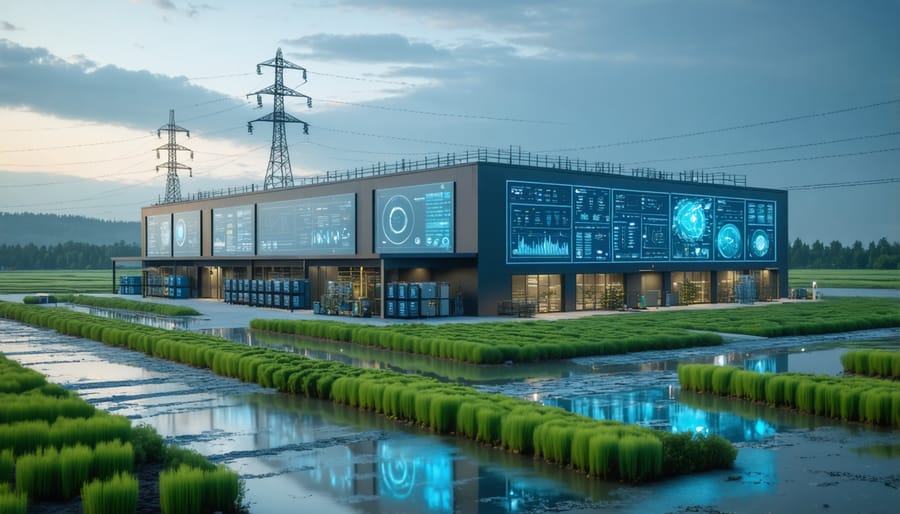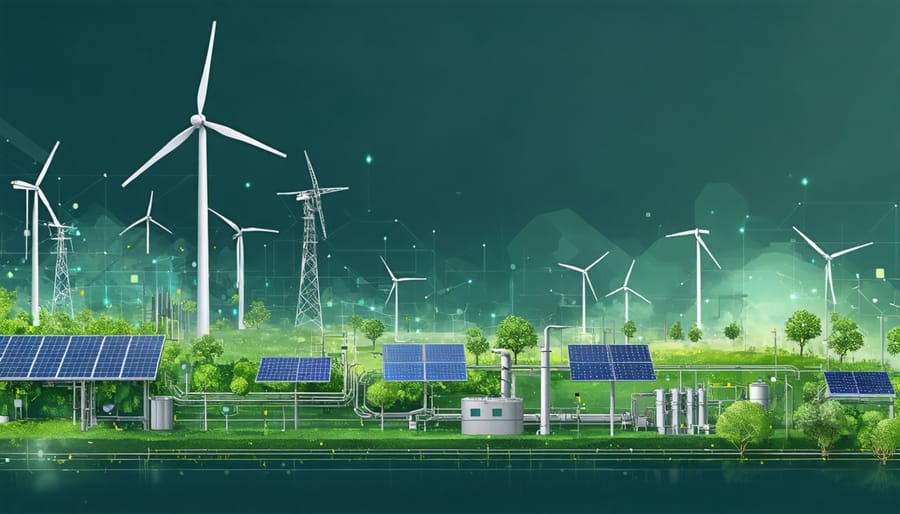Renewable energy innovation stands at the forefront of humanity’s response to climate change, driving a profound transformation in how we power our world. From floating solar farms dotting Australia’s reservoirs to breakthrough battery technologies revolutionizing energy storage, the pace of innovation has never been more dramatic or more crucial. In 2024, we’re witnessing an unprecedented convergence of technological advancement, market demand, and urgent environmental imperatives that’s reshaping the energy landscape.
Australia’s renewable sector has emerged as a global innovation hub, where traditional solar and wind technologies are being reimagined through groundbreaking research and development. Local innovators are pioneering hybrid systems that combine multiple renewable sources, while artificial intelligence optimizes energy distribution with unprecedented efficiency. These innovations aren’t just laboratory curiosities – they’re driving real-world changes, creating thousands of jobs, and attracting billions in international investment.
As we face increasingly urgent climate challenges, renewable energy innovation offers more than just environmental benefits. It presents a powerful economic opportunity, promising energy independence, reduced costs, and sustainable growth. The solutions being developed today will define not just our energy future, but our capacity to build a more resilient and sustainable world for generations to come.
Smart Integration: How Bioenergy Powers Modern Australian Communities
Next-Generation Biomass Processing
Australia’s biomass processing sector is undergoing a remarkable transformation, with innovative technologies reshaping how we convert organic waste into valuable energy resources. By embracing circular economy principles, local facilities are achieving unprecedented efficiency levels in converting agricultural residues, forestry waste, and organic municipal waste into clean energy.
Leading this revolution is the development of advanced enzymatic breakdown techniques, which significantly reduce processing time while increasing energy yield. These new methods are particularly effective with tough agricultural materials like sugarcane bagasse and wheat stubble, common throughout rural Australia.
Several facilities across Queensland and Victoria have implemented cutting-edge gasification systems that transform biomass into synthesis gas with minimal waste. This technology produces both renewable energy and valuable by-products, including biochar for soil improvement and agricultural applications.
The game-changer has been the integration of artificial intelligence and machine learning systems, which optimize processing conditions in real-time. These smart systems adjust temperature, pressure, and processing speeds based on biomass composition, resulting in energy conversion efficiency improvements of up to 40% compared to traditional methods.
Perhaps most exciting is the development of mobile processing units, perfect for remote Australian communities. These compact systems can process biomass on-site, reducing transportation costs and making renewable energy more accessible to regional areas.

Smart Grid Integration Solutions
The integration of bioenergy systems into Australia’s existing power infrastructure represents a significant leap forward in renewable energy innovation. Modern smart grid technologies are revolutionising how we harness and distribute power from biological sources, creating a more resilient and flexible energy network across the continent.
In practice, these integration solutions work through sophisticated monitoring and control systems that balance power supply and demand in real-time. For instance, the Mount Gambier Biomass Plant seamlessly coordinates with South Australia’s power grid, adjusting its output based on peak usage times and complementing other renewable sources like solar and wind.
Smart meters and advanced sensors play a crucial role in this integration, enabling two-way communication between bioenergy facilities and the broader grid network. This technological symphony allows for precise load management and helps prevent system overloads, particularly during extreme weather events that have become more common in our climate.
The success of these integration efforts is evident in regional communities like Cowra, NSW, where a biogas facility not only powers local industries but also provides grid stability during peak demand periods. This intelligent integration has reduced power outages by 45% while maintaining consistent supply to critical infrastructure.
Looking ahead, emerging AI-driven grid management systems are set to further enhance the efficiency of bioenergy integration, making it an even more reliable contributor to Australia’s energy mix. These innovations are paving the way for a more sustainable and interconnected energy future, where bioenergy works hand in hand with existing infrastructure to power our communities.
Agricultural Innovation Meets Energy Production
Waste-to-Energy Success Stories
Australian farmers are leading the charge in waste management innovation, transforming agricultural by-products into valuable energy resources. The Darling Downs region in Queensland showcases this transformation through the Pioneer Energy Project, where a collective of dairy farmers converted methane from cattle waste into electricity, powering over 1,800 homes and reducing their energy costs by 60%.
In Victoria’s Goulburn Valley, the Murphy family farm revolutionized their operations by implementing an anaerobic digestion system that processes fruit waste from their orchards. This system not only generates enough biogas to power their cold storage facilities but also produces nutrient-rich fertilizer as a by-product, creating a perfect circular economy model.
The Southern Cross Farms in New South Wales demonstrates another inspiring success story. Their innovative approach to processing cotton gin trash and other crop residues generates 3.5 megawatts of clean energy annually, enough to power their entire operation and feed excess electricity back into the grid. This initiative has created new revenue streams while solving waste disposal challenges.
Perhaps most impressive is the collaborative effort in Western Australia’s wheat belt, where a consortium of grain farmers established a shared biomass facility. Converting wheat stubble and other agricultural waste into bioenergy, this facility now powers five communities, creating local jobs and reducing the region’s carbon footprint by an estimated 85,000 tonnes annually.
These success stories demonstrate how Australian farmers are turning waste challenges into opportunities, proving that sustainable agriculture and energy production can go hand in hand.

Dual-Purpose Farming
Australian farmers are pioneering an innovative approach to land management by transforming their properties into dual-purpose powerhouses that produce both food and renewable energy. This clever integration, often called agrivoltaics, is revolutionizing the agricultural sector while contributing to Australia’s renewable energy goals.
In the sun-drenched fields of Queensland, sheep farmers are now grazing their flocks beneath elevated solar panels, making optimal use of available land. The panels provide shade for the animals, reducing heat stress and improving grazing conditions, while simultaneously generating clean energy. Studies show that this approach can increase land productivity by up to 60%.
Victoria’s wine country has embraced similar innovations, with vineyards installing solar panels above their grape rows. The partial shade from the panels helps protect grapes from extreme heat and reduces water consumption, while the gaps between panels ensure adequate sunlight for photosynthesis. These systems generate enough power to run entire winery operations and export excess energy to the grid.
In Western Australia, innovative farmers are combining wind turbines with broadacre farming. The turbines occupy minimal ground space, allowing crops to grow right up to their bases. A single turbine can power up to 3,000 homes while taking up less than 1% of the farm’s productive land.
These dual-purpose farming initiatives are creating new revenue streams for farmers while contributing to Australia’s renewable energy targets. The approach has proven particularly valuable during drought periods, providing farmers with a reliable secondary income source when crop yields are affected by challenging weather conditions.
Breaking Through Traditional Barriers
Storage Solutions
The breakthrough in energy storage technologies is transforming Australia’s renewable energy landscape, making intermittent power sources like solar and wind increasingly reliable. Leading this revolution are advanced battery systems, with the Hornsdale Power Reserve in South Australia standing as a shining example of large-scale storage success. This Tesla-built facility, affectionately known as the “Big Battery,” has demonstrated remarkable capability in stabilizing the grid and reducing costs.
Beyond lithium-ion batteries, innovative storage solutions are emerging across the country. Pumped hydro facilities, such as the Snowy 2.0 project, utilize Australia’s natural topology to store energy by pumping water uphill when power is abundant and releasing it through turbines when needed. Meanwhile, thermal energy storage systems are gaining traction, with molten salt technology allowing solar thermal plants to generate electricity well after sunset.
Hydrogen storage is another frontier showing promise, particularly in remote communities. The Western Australian city of Denham is pioneering a hybrid system combining solar power with hydrogen storage, creating a blueprint for sustainable, off-grid energy solutions.
These storage innovations are complemented by smart grid technologies and advanced energy management systems, ensuring efficient distribution and optimal usage. Virtual power plants are connecting household batteries across neighborhoods, creating coordinated networks that enhance grid stability and maximize renewable energy utilization.

Cost-Effective Implementation
Implementing renewable energy solutions has traditionally been viewed as a costly endeavor, but innovative financing models are reshaping this perception, particularly in Australia’s bioenergy sector. Forward-thinking organizations are now accessing sustainable investment opportunities through creative funding mechanisms that make bioenergy projects more achievable than ever before.
Power Purchase Agreements (PPAs) have emerged as a game-changer, allowing businesses to implement bioenergy systems with minimal upfront costs. These agreements enable organizations to pay for the energy they use while the provider maintains ownership of the infrastructure. Several Australian agricultural businesses have successfully adopted this model, transforming waste into energy while significantly reducing their operational costs.
Community-funded bioenergy projects are gaining traction across regional Australia, with local investors pooling resources to establish shared facilities. The Cowra Biomass Project serves as a brilliant example, where local farmers collectively invested in a biogas facility that now powers hundreds of homes while processing agricultural waste.
Equipment leasing programs and government incentives have further streamlined the adoption process. The Clean Energy Finance Corporation’s specialized funding programs have helped numerous businesses transition to bioenergy systems through low-interest loans and flexible repayment terms. These innovative financing solutions, combined with decreasing technology costs, are making bioenergy an increasingly attractive and accessible option for Australian businesses of all sizes.
The Road Ahead: Future Innovations
The future of bioenergy in Australia is brimming with promising innovations that could revolutionise our renewable energy landscape. Cutting-edge research in microalgae cultivation shows particular promise, with scientists developing more efficient strains that can produce up to 30 times more energy per hectare than traditional biofuel crops. These advances in algal biotechnology could transform our coastal areas into sustainable energy powerhouses.
Emerging waste-to-energy technologies are evolving rapidly, with new thermal conversion processes that can handle multiple waste streams simultaneously. Australian researchers are pioneering hybrid systems that combine anaerobic digestion with advanced gasification, maximising energy recovery while minimising environmental impact.
Agricultural innovation is driving the development of purpose-designed energy crops that thrive in our unique climate. These new varieties require minimal water and can grow on marginal lands, avoiding competition with food production. The integration of smart farming techniques and AI-driven crop management systems is optimising biomass yields while reducing resource inputs.
The convergence of bioenergy with other renewable technologies is opening exciting possibilities. Hybrid systems combining solar thermal with biomass gasification are showing promising results in pilot projects, offering more reliable and consistent power generation. These innovations are attracting significant green energy financing and investment interest.
Looking ahead, we’re seeing the emergence of ‘smart’ bioenergy facilities that use artificial intelligence to optimise processing efficiency and reduce emissions. These systems can adapt in real-time to changing feedstock qualities and energy demand patterns, representing the next generation of bioenergy infrastructure.
The development of community-scale bioenergy systems is another promising trend, with modular designs that can be easily scaled and adapted to local needs. These systems are particularly valuable for regional communities, offering energy independence while creating local jobs and supporting circular economy principles.
The journey towards a sustainable energy future is not just a possibility – it’s already unfolding across Australia. From solar farms in the outback to innovative wave energy projects along our coastlines, renewable energy innovation is reshaping our relationship with power generation and consumption. These advancements represent more than just technological progress; they’re our pathway to energy independence and environmental stewardship.
The transformative potential of renewable energy extends far beyond environmental benefits. It’s creating thousands of jobs, driving economic growth in regional communities, and positioning Australia as a global leader in sustainable technology. Our success stories, from community solar initiatives to large-scale wind farms, demonstrate that we have the expertise, resources, and determination to make this transition work.
However, innovation alone isn’t enough – we need collective action to turn potential into reality. Whether you’re a homeowner considering solar panels, a business leader exploring sustainable practices, or a community member supporting local renewable projects, your participation matters. The time to embrace these innovations is now.
By investing in renewable energy today, we’re not just choosing cleaner power; we’re investing in our children’s future. Let’s work together to accelerate this transformation, support emerging technologies, and create an energy landscape that works for all Australians. The renewable energy revolution is here – and everyone has a part to play in its success.

